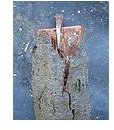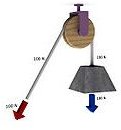How Do Simple Machines Make Work Easier?
How Simple Machines Work
What is a simple machine and how do they work? I’m so glad you asked! Machines make work easier by changing the size of force, direction of force, or distance the force acts on.
Lifting a car with a flat tire and loosening the lugnuts can be accomplished by a single person thanks to simple machines. The jack and lug wrench are simple machines that alter the force needed to change the tire.
Six Simple Machines
Simple machines are basic devices used to alter the force needed to accomplish a task. There are six types of simple machines.
- lever
- wheel and axle
- inclined plane
- wedge
- screw
- pulley
Levers

The first type of simple machine is the lever. A lever is a rigid bar that rotates on the fixed point of a fulcrum and changes the distance or size of a force.
There are three classes of levers. A first class lever has an input force and output force on either side of the fulcrum. This causes the output to move in the opposite direction of the the input force. An example of a first class lever is a see-saw. A second class lever has an output force between the input force and fulcrum. This changes the distance of the force. A wheelbarrow is a second class lever. The third class lever has the input force between the output and fulcrum. A broom is a third class lever.
Wheel and Axle
The wheel and axle make work easier by changing the distance the force acts on. A wheel and axle consists of two disks or

cylinders with different radiuses. Examples are a steering wheel and shaft, a car wheel and axle, and a screwdriver.
Inclined Plane
An inclined plane is a slanted surface on which a force can move an object to a different elevation. Why do gentler slopes and ramps require less energy to move a load on? Because the input force required to travel the greater distance of a slope is changed to the smaller distance of the output force – the upward motion.
Wedge

A wedge is a device made of two back to back inclined planes and is used to split objects. When a wedge is driven into a log, the size of the input force at the wider top of the wedge is changed to greater output force at the narrower point forcing the wedge through the wood. Knife blades are an example of a wedge.
Screw
A screw is an inclined plane wrapped around a cylinder. Screws with threads closer together require

less force to turn because the length of the inclined plane is longer. Nuts and bolts are screws. A nut is a screw with the threads on the inside.
Pulley
The last type of simple machine is the pulley. A pulley consists of a rope that fits into a groove in a wheel. A pulley makes work easier by changing the direction or direction and size of the force.
There are three types of pulleys. They are the fixed pulley, moveable pulley and pulley system.

The fixed pulley is a single fixed pulley and rope. This changes the output direction of the force, making it opposite of the input. When you pull down on a fixed pulley a weight is lifted up.
A moveable pulley is fixed to the object being moved instead of a fixed location. Moveable pulleys multiply the input force needed to lift a heavy object thus reducing the force needed to lift heavy objects. Moveable pulleys are used to move ship sails and window washer platforms.
Pulley systems combine fixed and moveable pulleys to create large mechanical advantages. A crane uses pulley systems to lift enormous loads like locomotives.
References
- Michael Wysession, David Frank, Sophia Yancopoulos. Physical Science Concepts in Action. p.417 - 435. New Jersey: Prentice Hall, 2004.
